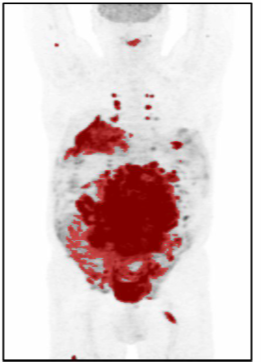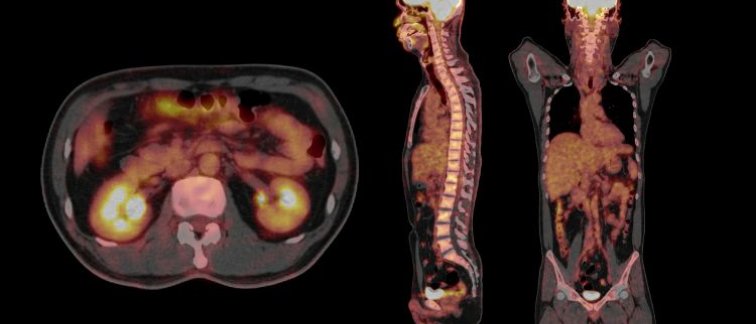Center Amsterdam greatly improves the prediction of prognosis of patients with diffuse large B cell lymphoma after first-line treatment by including an optimal characterization of metabolic tumor volume from PET/CT scans.
Diffuse large B cell lymphoma is a type of non-Hodgkin lymphoma, a cancer of the lymphatic system. Before starting treatment for this aggressive lymphoma, patients and doctors naturally want to know what the prognosis will be after applying the standard therapy.
Updating a 30-year-old prediction model
The International Prognostic Index (IPI) has been used for estimating the prognosis of diffuse large B-cell lymphoma patients since 1993. Metabolic tumor volume (MTV) refers to the metabolically active volume of the tumor and has also been useful in predicting outcome in diffuse large B-cell lymphoma, but the optimal way to use MTV was unknown.
An international consortium including researchers at Cancer Center Amsterdam (PETRA consortium) has examined the relationship of MTV with survival and established a new international metabolic prognostic index, published in the Journal of Clinical Oncology.
More accurate scans
The researchers show that the new prognostic index (called International Metabolic Prognostic Index = IMPI) vastly outperforms the current standard IPI score based on the analysis of PET scans and clinical data from 1,200 patients with diffuse large B cell lymphoma.
The improvement is due to advances in PET scanning and quantitative PET analysis. 18F-fluorodeoxyglucose (FDG)-positron emission tomography (PET)/computed tomography (CT) provides more accurate information regarding the biological behavior and tumor mass of each individual patient.
“Our new model combines MTV from FDG PET-CT scans and age as continuous variables, along with stage, and predicts relapse and survival better than IPI,” says Josée Zijlstra, Professor of Hematology at Amsterdam UMC. “Importantly, it enables individualized estimates of patient outcome.”
The simple and robust new prognostic index can be used in clinical practice and clinical trials for adults with newly diagnosed DLBCL.

Metabolic tumor volume image.
For more information, contact Prof. Josée Zijlstra, go to www.petralymphoma.org, or read the scientific publication:
N. George Mikhaeel, et al. (2022) Proposed New Dynamic Prognostic Index for Diffuse Large B-Cell Lymphoma: International Metabolic Prognostic Index. J. Clin. Oncol. https://doi.org/10.1200/jco.21.02063.
Researchers involved from Amsterdam UMC:
Martijn W. Heymans, Jakoba J. Eertink, Henrica C.W. de Vet,Ronald Boellaard, Sanne E. Wiegers, Gerben J.C. Zwezerijnen, Otto S. Hoekstra, Josée M. Zijlstra
And international partners from our PETRA Consortium;
Ulrich Dührsen, Luca Ceriani, Christine Schmitz, Andreas Hüttmann, Pieternella J. Lugtenburg, Emanuele Zucca, Sally F. Barrington, N. George Mikhaeel.
Funded by a Grant from the Dutch Cancer Society: KWF 11648: Radiomics; extracting new tumor characteristics from baseline PET-CT images for better prediction of outcome in DLBCL patients.

